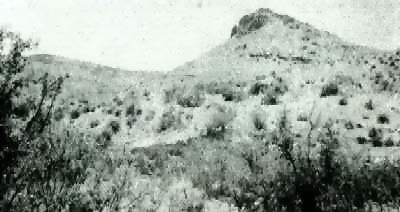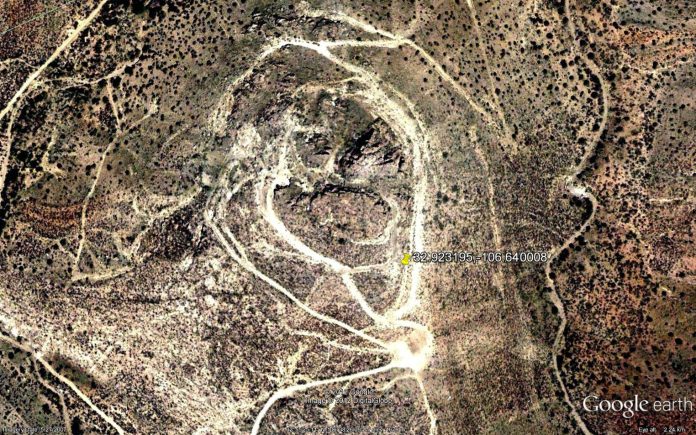
The Mystery
In 1937, Doc Noss—part-adventurer, part-conman—and his wife Babe discovered fabulous treasure inside the caverns of New Mexico’s Victorio Peak. They dynamited the tunnel to hide the treasure from other treasure hunters. At least that’s what they said happened.

The Legend
November 1937, Doc, Babe, and four others left on a deer hunt into the Hembrillo Basin. Setting up camp on the desert floor at the base of Victorio Peak, the men headed into the wilderness, while their wives stayed at camp. Hunting by himself, Doc scouted the base of the mountain. When it began to rain, Doc sought shelter under a rocky overhang near the summit of the mountain. While waiting for the rain to subside he noticed a stone that looked as if it had been “worked” in some fashion. Reaching down, he was unable to budge it, but after digging around the rock, he got his hands under it. Lifting the rock, he found a hole that lead straight down into the mountain.
Peering into the darkness, Doc saw an old man-made shaft with a thick, wooden pole attached at one side. Doc thought that he had discovered an old abandoned mineshaft. When the rain finally stopped, Doc returned to camp, telling Babe of the discovery. The two decided to keep the discovery between themselves and return to the inspect the shaft later.
Within just a few days, Doc and Babe were back at the site with ropes and flashlights. Testing the old wooden pole attached to one side of the passage, Doc rejected the idea of using it dropped into the shaft with a rope instead. While Babe looked on from above, Doc inched his way down the narrow passageway into the mountain nearly sixty feet. Near the bottom, he encountered a huge boulder hanging from the ceiling, almost blocking his way.
Finally reaching the bottom, Doc stepped into a chamber the size of a small room. On the walls were drawings , some painted and others chiseled, that appeared to have been made by Indians. At one end of the chamber, the shaft continued downward. Once again, Doc began to descend, this time about 125 feet before the shaft again leveled off into a large natural cavern. Several smaller rooms had been chiseled from the rock along one wall. Stepping into the eerie darkness, Doc was alarmed when he saw a human skeleton, kneeling and securely tied to a stake driven into the ground. The skeleton’s hands were bound behind its back — apparently, the person had been deliberately left there to die. Within moments he found more skeletons, most of them bound and secured to stakes like the first. Exploring further he found yet even more skeletons stacked in a small enclosure, much like a burial chamber. All told, he reportedly found twenty-seven human skeletons in the caverns of the mountain.
As Doc continued to explore the side caverns, he found a hoard of treasure including coins, jewels, saddles and priceless artifacts including a gold statue of the Virgin Mary. He also found some old letters, the most recent of which was dated 1880. This treasure was only the beginning. In a deeper cavern, Doc found what he thought was a stack of worthless iron bars. He estimated there were thousands of these bars, each weighing over forty pounds stacked against a wall. He was barely able to lift one, mush less think of carrying it back to the surface. Later, the wealth in the cave would be calculated to be worth more than two billion dollars. Doc filled his pockets with gold coins, grabbed a couple of jeweled swords, and laboriously returned to Babe waiting anxiously at the surface. After telling her about what he’d seen and showing her the loot, she insisted he go back into the mine for one of the iron bars. After much searching, he found a small iron bar that he could carry back through the narrow passageway. When he reached the surface, he told Babe, “This is the last one of them babies I’m gonna bring out.” Babe rolled the bar over and noticed a yellow gleam where the gravel of the hillside had scratched off centuries of black grime. What looked like a piece of iron was actually a solid gold bar.
After the discovery of the treasure, Doc and Babe spent every free moment exploring the tunnels inside the peak, living in a tent at the base of it. On each trip, Doc would retrieve two gold bars and as many artifacts as he could carry. At one time, he brought out a crown, which contained two hundred forty-three diamonds and one pigeon-blood ruby. Yet, Doc trusted no one, not even Babe, disappearing into the desert, hiding pieces of the treasure in places that he never revealed.
Among the artifacts, Doc is reported to have retrieved were documents dated 1797, which he buried in the desert in a Wells Fargo chest along with various other treasures. Although the originals have never been recovered, a copy of one of the documents was a translation from Pope Pius III:
The Treasure
Believers think that Doc Noss found the Casa del Cueva de Oro, Spanish for the House of the Golden Cave. “Soledad” was the former name of Victorio Peak, and Doc apparently found the seventh door located at high noon, but the promised health, wealth, and honor would evade him. Four years before his discovery, Congress had passed the Gold Act, which outlawed the private ownership of gold, so Doc would be unable to profit from his treasure on the open market. He didn’t care about the historical value of the treasure’s inside Victorio Peak, so he mostly ignored the pouches, packs and artifacts, while he concentrated on the gold coins and bars. Although he was unable to sell the gold bars on the open market, Noss continued to work steadily to remove the treasure.
In the spring of 1938, Doc Noss and Babe went to Santa Fe to establish legal ownership of the find, filing a lease with the State of New Mexico for the entire section of land surrounding Victorio Peak. Subsequently, he also filed several mining claims on and around Victorio Peak, as well as a treasure trove claim. With legal ownership established, Noss began to openly work the claim, but he also became increasingly paranoid, hiding the gold bars all over the desert.
Source: McGuires Place, Read More














